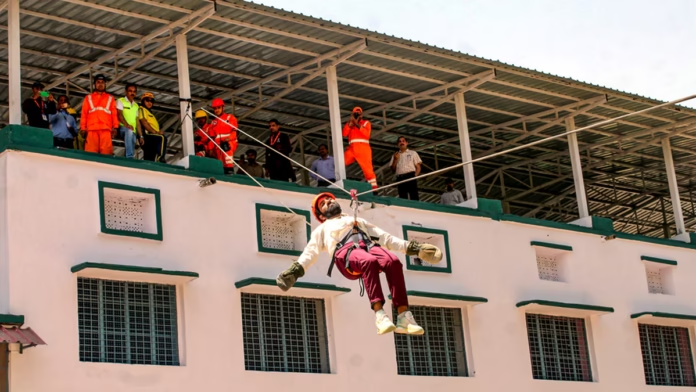With Indo-Pak tensions rising after the recent Pahalgam terror attack, India is set to carry out its first nationwide civil defence mock drill since the 1971 war. The exercise, named Operation Abhyaas, will take place on May 7, 2025, across 244 districts, including several from the Northeast.
What Operation Abhyaas Involves
The Ministry of Home Affairs has directed all participating districts to simulate real wartime or high-threat scenarios. Citizens can expect:
- Air raid sirens activated in major urban areas.
- Crash blackouts, replicating wartime power cuts to protect sensitive infrastructure.
- Evacuation drills and mock movement of civilians to safer zones.
- Camouflaging of installations deemed vulnerable to attacks.
- Testing of control rooms, communication systems, and backup lines.
- Public training sessions on blackout safety, sheltering, and emergency response.
Volunteers from Home Guards, NCC, NSS, NYKS, and local communities will join district authorities, making this a comprehensive, citizen-inclusive drill.
Northeast at the Core of Preparedness
The Northeastern region, due to its sensitive geography and strategic importance, has been placed under both Category II and Category III preparedness zones. Districts identified for the drill include:
- Arunachal Pradesh: Aalo, Itanagar, Tawang, Hayuliang, Bomdila
- Assam: Guwahati, Dibrugarh, Jorhat, Tezpur, Tinsukia
- Manipur: Imphal, Churachandpur, Ukhrul, Moreh, Ningthoukhong
- Meghalaya: Shillong, Jowai, Tura
- Mizoram: Aizawl
- Nagaland: Kohima, Dimapur, Mokokchung, Mon, Phek, Tuensang, Wokha, Zunheboto, Kiphire, Peren
- Sikkim: Gangtok
- Tripura: Agartala
In these districts, civil defence teams are working with local administrations to coordinate blackout schedules, emergency announcements, and citizen participation.
National Context of the Mock Drill
While the Northeast is playing a crucial role, Operation Abhyaas is a pan-India initiative. Cities such as Delhi, Mumbai, Chennai, and Hyderabad will also take part, testing their ability to deal with sudden alerts, power cuts, and evacuation calls.
The exercise is not only a security preparedness measure but also a reminder of the importance of civilian resilience. It highlights how a well-informed public can complement military and police operations in times of crisis.

Why the Mock Drill Matters Now
- Historic Importance: This is the largest civil defence mock drill in over five decades, reflecting renewed seriousness about civilian readiness.
- Geopolitical Timing: With cross-border tensions escalating, the drill reassures citizens and signals preparedness to adversaries.
- Community Involvement: Unlike purely military drills, this exercise puts ordinary citizens at the center of response and safety mechanisms.
- Regional Inclusion: By actively involving the Northeast, the government ensures that preparedness extends to every corner of India.
Expected Outcomes
Authorities will assess several key aspects after May 7:
- Response efficiency of civil defence control rooms and emergency services.
- Citizen awareness, measured by participation in blackout and evacuation drills.
- Inter-agency coordination, ensuring local administrations, volunteers, and security forces operate seamlessly.
- Infrastructure resilience, including backup power and communication systems.
Once Operation Abhyaas concludes, a detailed review will guide improvements in civil defence strategies. Regular drills, enhanced public awareness campaigns, and better infrastructure investment are likely to follow.
For the Northeast, the exercise represents more than a precautionary step—it is a statement of inclusion and preparedness, ensuring that the region is not left out of national security frameworks.
As India balances regional challenges and global ambitions, civil defence readiness will remain a vital pillar of its security architecture. The May 7 mock drill is not just a test—it’s a wake-up call for citizens to recognize their role in safeguarding the nation during uncertain times. in safeguarding the nation during uncertain times.
ALSO READ: Holi 2025: Auspicious Date, Muhurat, Rituals & Significance of the Festival












